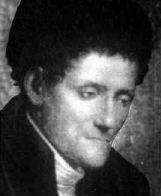

Paolo Ruffini entered the University of Modena in 1783 where he studied mathematics, medicine, philosophy and literature. Among his teachers of mathematics at Modena were Luigi Fantini, who taught Ruffini geometry, and Paolo Cassiani, who taught him calculus. In 1788, Ruffini graduated with a degree in philosophy, medicine and surgery. Soon after this he graduated with a mathematics degree.
He was appointed professor of the foundations of analysis, and then in
1791, Ruffini was appointed Professor of the Elements of Mathematics. In 1798, he was required to swear an oath of allegiance to the republic and this Ruffini found he could not bring himself to do on religious grounds. By failing to swear the oath he lost his professorship and was barred from teaching.
Thus he had more time to practice medicine, and therefore help his patients to whom he was extremely devoted. It also gave him the chance to work on what was one of the most original of projects, namely to prove that the quintic equation cannot be solved by radicals. Among the others who had made serious attempts to understand the problem were Tschirnhaus, Euler, Bézout, Vandermonde, Waring and Lagrange.
It appears that nobody before Ruffini really believed that the quintic could not be solved by radicals. In 1799, Ruffini published a book on the theory of equations with his claim that quintics could not be solved by radicals.
Ruffini used group theory in his work but he had to invent the subject for himself. Lagrange had used permutations and one can argue that groups appear in
Lagrange's work but since Lagrange never composed permutations it is rather with hindsight that we now see the beginnings of group theory in his paper.
Ruffini is the first to introduce the notion of the order of an element, conjugacy, the cycle decomposition of elements of permutation groups and the notions of
primitive and imprimitive. He proved, among other things, that
the order of a permutation is the least common multiple of the lengths in the decomposition into disjoint cycles, and that S5 has no subgroups of index 3, 4 or 8.
It is remarkable work and, except for one gap, proves the theorem as Ruffini claimed.
But the mathematical community had no response.
One has to feel desperately sorry for Ruffini. If some mathematician had written to him showing him there was an error or even a gap in the proof, then at
least Ruffini would have had the chance to correct it. However, it seemed that nobody really wanted to know that quintics could not be solved by radicals.
He left the University of Modena to spend 7 years teaching
applied mathematics in the military school in Modena. He continued to practice medicine and tend to patients from the poorest to the richest in society. After
the fall of Napoleon, Ruffini became rector of the University of Modena in 1814.
He also held a chair of applied mathematics, a chair of practical medicine and a chair of clinical medicine in the University of Modena.
In 1817, there was a typhus epidemic and Ruffini continued to treat his patients until he caught the disease himself. Although he made a partial recovery, he never fully regained his health and in 1819 he gave up his chair of clinical medicine. He did not give up his scientific work, however, and in 1820 he published a scientific article on typhus based on his own experience with the disease. He wrote several works on philosophy, one of which argues against some of
Laplace's philosophical ideas. He also wrote on probability and the application of probability to evidence in court cases.